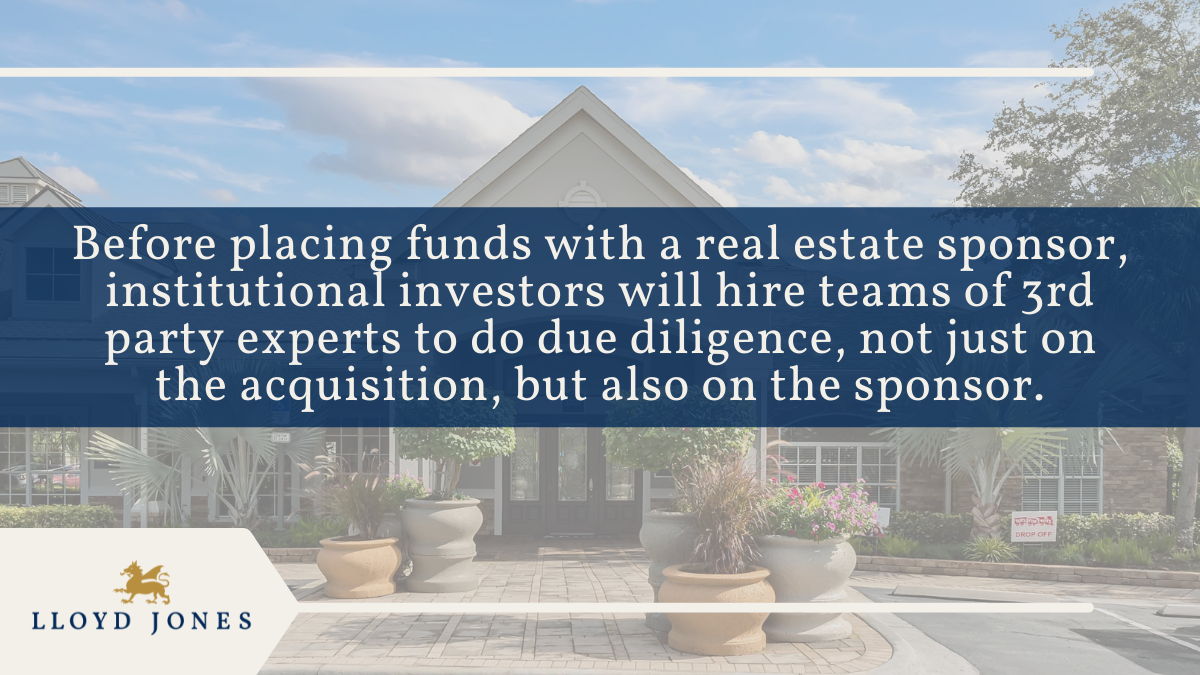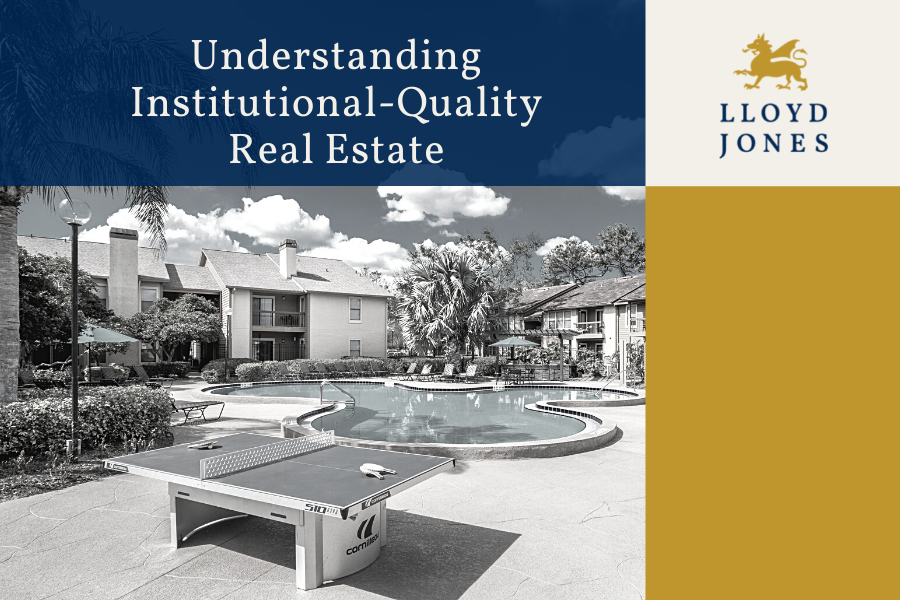Until recently, access to some of the most premier commercial real estate deals has been reserved for only a select few. This “select few” is usually comprised of institutional investors, like insurance companies and hedge funds, who have tens of millions of dollars to invest in single transactions.
Changes to SEC regulations have, for the first time, opened the door for individual, accredited investors to invest in institutional-quality real estate. However, most people are unfamiliar with institutional-caliber assets. In this article, we offer a primer on institutional-quality real estate.
What Is Institutional-Quality Real Estate?
Institutional-quality real estate is among the highest-quality, and therefore, some of the most-expensive real estate in the country. These assets are sometimes referred to as “trophy” properties. They include high-rise office buildings, apartment communities with hundreds of units apiece, top-tier senior-living facilities and more.
One of the distinguishing characteristics of institutional-quality real estate is that it requires significant equity. These properties can easily cost $30 million to $300 million and require 30 to 40 percent equity. To put that in perspective, someone buying a property for $200 million would need upwards of $80 million in equity before securing debt to cover the balance of the acquisition. This is much different than the real estate most investors would buy—properties with two, four, or even 20+ units that can be purchased with as little as 3 to 10 percent down.

Historically, very few people have had the opportunity to invest in institutional-quality real estate. The sheer size and cost of these properties makes them cost-prohibitive to individual investors. Instead, these properties are typically purchased by sophisticated investment groups that already own a large portfolio of similar assets.
What Is an Institutional Investor?
Institutional investors are those with the experience and financial capacity needed to purchase institutional-quality real estate. These groups include endowments, pension funds, insurance companies, traditional commercial banks, hedge funds, mutual funds, sovereign wealth funds, private equity funds and large family offices.
Most institutional investors are the fiduciary for hundreds, thousands, or even hundreds of thousands of beneficiaries who have entrusted the company with their hard-earned capital. For example, teachers regularly pay into a pension fund. Rather than just banking members’ dues, the pension fund invests the capital to earn modest but consistent returns. One of the ways that a pension fund might invest is by purchasing institutional-quality real estate.
Institutional investors are generally considered “limited partners” when investing in real estate. They invest capital with a sponsor, or “general partner,” who then oversees the deal on the investors’ behalf. Depending on how a deal is structured, the LP investors may have little to no influence over daily decision-making. Instead, they trust the sponsor to earn them their anticipated returns and generally step aside while the sponsor works to do just that.
That said, while a sponsor has day-to-day oversight and responsibility for executing on a real estate business plan, institutional investors will generally retain major decision rights in projects they invest in. For example, they may retain decision rights over debt levels, recapitalizations, sales of assets, budgetary expenditures over certain thresholds, and the like. In some circumstances, institutional investors will also retain the right to remove a sponsor in the event a business plan goes substantially off course. While these rights are not often exercised, they serve to provide investors with a level of control over their investments to ensure projects run as planned.
How Buyers of Institutional-Level Investments Are Vetted by Sellers
With standard real estate transactions, a property will be openly listed for sale and then the seller will evaluate all offers made by prospective buyers. Often, the seller will choose the highest-price offer without much consideration for the buyer’s real estate experience or other credentials.
The process for buying institutional-quality real estate is much different. Instead, sellers will usually enlist the support of a commercial real estate broker who will put out an “offering memorandum” that provides robust details about the property. The OM helps to create a level playing field from which buyers can then begin their own due diligence.
Prospective buyers will then indicate their interest by submitting an LOI, or letter of intent, to the broker. The seller, through the broker, will vet each of the prospective buyers and may then only invite a small group to actually bid on the property. Before allowing anyone into this smaller, more exclusive group, the sellers will want to feel confident that the buyers are able to execute, including that they have sufficient funds to purchase the property.
Those who make it into the smaller, more exclusive group of bidders will then be asked to participate in a “best and final” round, sometimes referred to as a “Buyer/Seller Call.” During this process, the seller will talk through the details of the potential transaction with each of the prospective buyers before selecting the winning bidder. Often, experience and track record are what differentiate one bidder from the others—more so than price or other purchase terms. In fact, it is not uncommon for the highest bidder to not win the deal if it does not have an established reputation, either in that market or with assets of similar size and quality.
The buyer’s reputation within the market and its ability to close cannot be emphasized enough. Given the complexity of buying and selling institutional-quality real estate, including transactions that can take months to complete, sellers want to transact with people who have proven backgrounds and track records. All else considered equal, sellers will choose to work with the buyer/sponsor with whom they feel they can have an effective relationship throughout the duration of the transaction (and potentially, beyond).
The buyer’s equity partner may also play an important role in the process. Throughout this acquisition period, potential buyers present the opportunity to institutions whose investment criteria match the specific investment. A strong institutional partner validates both the buyer/sponsor and the investment. And it implies the ability to close.
In the end, the winning buyer/sponsor becomes the general partner of the new ownership entity, partnering with an institutional investor as limited partner.
Standing Out on a Level Playing Field
Unlike investing in smaller, more traditional rental properties where buyers are expected to conduct their own due diligence, the process for buying institutional real estate starts with a more-level playing field. Bidders are all given the same due diligence package that includes the rent roll, operating expenses, capital expenses, projected rent growth, market information and more.
What differentiates buyers, then, is the ability to analyze this information. In other words, the winning bidder will need to understand the intricate dynamics of the property’s day-to-day operations and have a keen awareness of the nuances of the local market to understand whether the rent growth assumptions are accurate or potentially inflated. This requires a certain expertise that helps some buyers stand out from the rest, and in turn, allows those buyers to be more effective operators than their peers.
How Institutional-Level Buyers Underwrite Deals
There is a time between having an offer accepted and closing on the property – which may be 30 to 60 days – known as the “due diligence” period. The due diligence that investors conduct is very sophisticated and usually requires support from many third-party consultants. These consultants perform a range of detailed studies and analyses, from property condition reports to environmental and market studies and more.
For example, multifamily investors might use thermal imaging to determine the condition of a property’s exterior. They’ll likely have the roof inspected, plumbing and electrical assessed, irrigation lines checked, etc. Most will also conduct an inspection of each individual unit, documenting the condition of all kitchens and bathrooms, verifying unit layouts and what improvements will be needed upon close. A report will be created for each unit, including pictures that will be saved to each unit’s file.
While the physical property is being inspected, the team will also be doing lease audits, lien searches, market assessments and other financial analyses. They will begin getting quotes for repairs and improvements so they have a clear understanding of these costs that can be included in the underwriting. Having these quotes in hand will help to identify any significant variances compared to the initial underwriting.
What Institutional Investors Look for in a Sponsor

Before placing funds with a sponsor/partner, institutional investors do their due diligence, not just on the acquisition, but also on the sponsor.
The sponsor’s experience is of primary importance: How many years of successful transactions can the sponsor claim? The institution also expects the sponsor to be an expert in the asset class and market: How many similar assets does the sponsor have under management?
Operational expertise in the asset class is critical to any investment. The sponsor must have the infrastructure to manage its assets on a day-to-day basis. Furthermore, the sponsor must have an asset management team to ensure the business plan is followed and investment goals are met.
Finally, the institution expects the sponsor to provide institutional-level financial reporting up to SEC standards.
As the general partner of the ownership entity, the sponsor will be entrusted with a daunting responsibility, so it goes without saying that the institution demands a history of absolute integrity and ethical business practices from its partners.
What Sponsors Look for in Institutional Investors
Not all institutional investors are appropriate for every deal. It is important that the sponsor and its institutional partner share mutual goals and expectations.
The sponsor must clearly understand the investor’s investment-return criteria. The two must agree on the investment strategy. They must be aligned in their ultimate goals for the asset.
Although significant due diligence is required among all parties involved in the purchase or sale of institutional-quality real estate, the time and resources spent on vetting each other (and the property) in advance is what helps to ensure a successful transaction.
This lengthy due-diligence process is really just one part of a larger relationship-building process. Buyers, sellers, and brokers of institutional-quality real estate get to know each other well over time. The world of institutional real estate is small. Those with an established reputation in the marketplace will be best positioned to excel.
The question then becomes, “How can an individual participate in institutional-size investments?” “With all this due diligence and vetting, how can a private investor possibly access these ‘trophy’ properties?”
The good news is that SEC rulings have opened the door. By partnering with an experienced sponsor, smaller investors can join the institutions in large, high-quality investments and enjoy the same return benefits. Institutional-quality investments are no longer limited to institutional-size investors.
Are you interested in investing in institutional-quality real estate? Contact us today to learn more about Lloyd Jones, our investment track record, and the platform we have available to investors.
